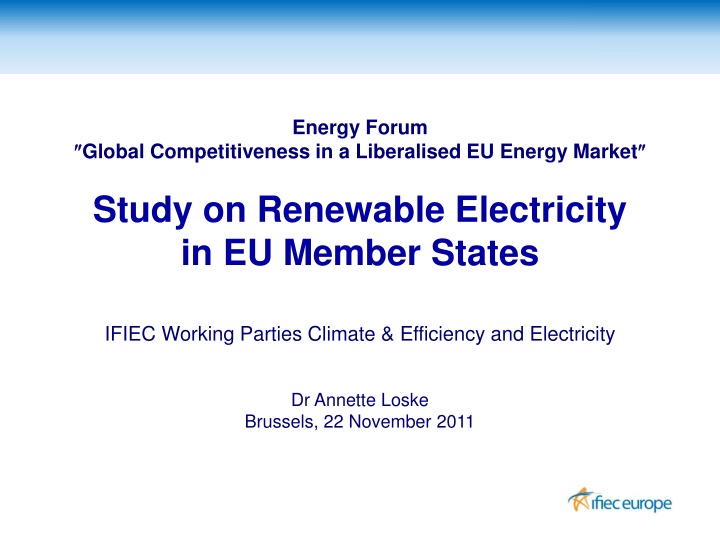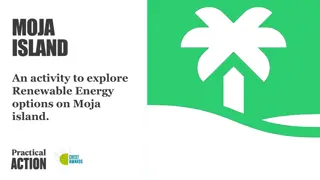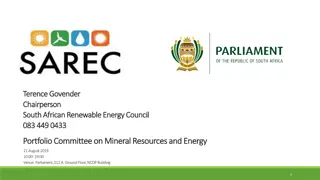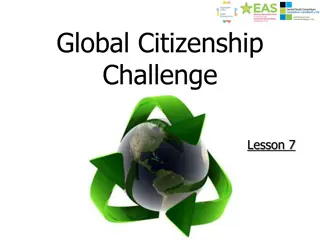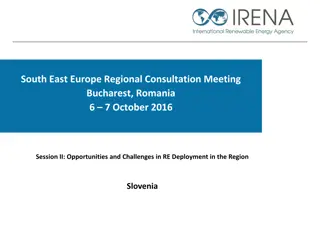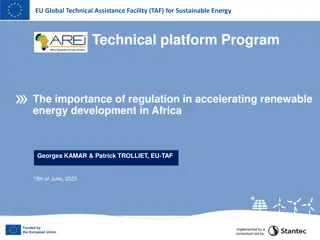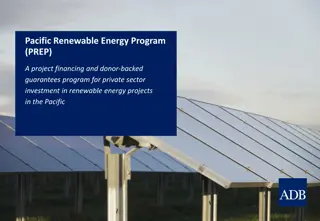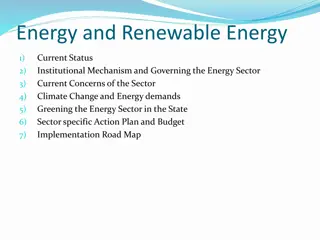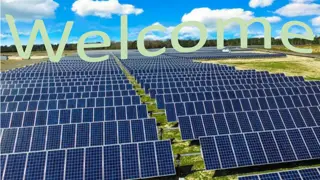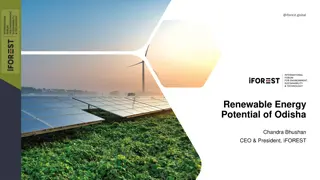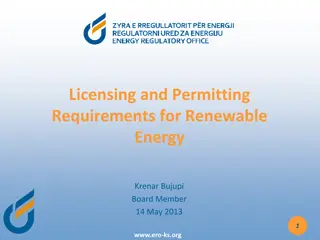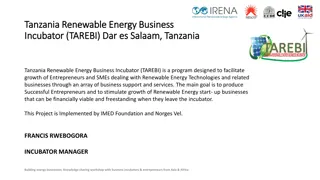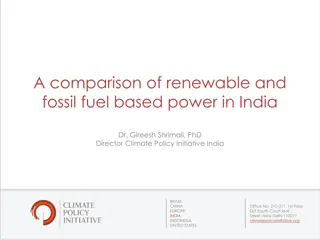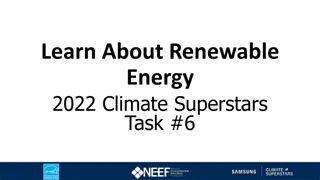Analysis of Renewable Energy Policies in the Liberalised EU Energy Market
This study examines the global competitiveness of the energy forum in a liberalised EU energy market, focusing on renewable electricity in EU member states. It delves into the energy balance, political context regarding European climate targets, industry involvement, and the financial context of renewable energy support. The analysis underscores the importance of coordinating renewable energy measures with energy efficiency strategies to ensure competitiveness, security, and sustainability in the industry.
Download Presentation

Please find below an Image/Link to download the presentation.
The content on the website is provided AS IS for your information and personal use only. It may not be sold, licensed, or shared on other websites without obtaining consent from the author.If you encounter any issues during the download, it is possible that the publisher has removed the file from their server.
You are allowed to download the files provided on this website for personal or commercial use, subject to the condition that they are used lawfully. All files are the property of their respective owners.
The content on the website is provided AS IS for your information and personal use only. It may not be sold, licensed, or shared on other websites without obtaining consent from the author.
E N D
Presentation Transcript
Energy Forum Global Competitiveness in a Liberalised EU Energy Market Study on Renewable Electricity in EU Member States IFIEC Working Parties Climate & Efficiency and Electricity Dr Annette Loske Brussels, 22 November 2011
Energy Balance Energy policy for serving industry must focus equally on all three elements Competitiveness Security sustainability Sustainability must not be developed at the expense of competitiveness but with the target to strengthen it. 2
Political Context 1. Background: European climate targets until 2020 a) Minimum 20% GHG reduction below 1990 level b) 20% energy consumption from renewable sources c) 20% reduction in primary energy use by improving energy efficiency Industry involvement a) Industry is already the main stakeholder impacted by the EU ETS scheme. b) Other sectors have to support the burden of RES. c) Industry s energy efficiency already improved a lot, there is little extra economic potential. No over-burdening of industry until a global fair playing-field is realised. 3
Political Context 2. EU industry s attitude: - does not demand it - does not reject it - but requires to safeguard in an RES-future competitive baseload supply = basis for industrial activity and realistic EU future as successful and innovative economic region 4
Political Context 3. Renewable measures must be coordinated with energy efficiency measures: Uncoordinated political measures lead to suboptimal solutions. Energy efficiency can soften the challenge of 20% RES and GHG reduction (less consumption 20% rest share decreased). Energy efficiency is industry s strategy for growth and competitiveness over last few decades. Energy efficiency should be the focus. Industries past efforts must be kept in mind while focussing on energy efficiency in future. Industry already did its share of work. 5
Financial Context Average RES support levels in / MWh /MWh 120 106.79 103.00 100 76.27 80 74.85 73.37 61.34 60 45.91 39.07 36.83 40 31.21 20 0 Belgium Czech Rep. Denmark France Germany Hungary Italy Netherlands Spain UK 6 Source: CEER Report on Renewable Energy Support in Europe.
Financial Context Surcharge on electricity price due to support schemes for renewable electricity in / MWh 40 Worst case scenario: burden for consumers without compensation unbearable for industry 35 30 25 20 15 10 5 0 /MWh Belgium Bulgaria Czech Republic Denmark France Germany Italy UK 2007 2008 2009 2010 2011 2012 2013 2014 2020 7
Financial Context % of electricity in renewable production: Development until 2008 vs. targets until 2020 Red column targets mean: much more action is needed very quickly. Trend: Even higher support needed! 60 50 40 30 20 10 0 % EU (27 countries) Belgium Bulgaria Czech Rep. 2006 (EUROSTAT) Denmark Finland 2007 (EUROSTAT) France Germany 2008 (EUROSTAT) Hungary Italy 2010 (NREAP) Netherlands Spain 2020 (NREAP) UK 2005 (EUROSTAT) Source: EUROSTAT, NREAP 8
Financial Context % of renewable electricity in total electricity consumption: 2010 target (2001/77) vs. expectation (acc. to NREAP) 5.3 6.0 4.9 % 4.0 3.0 2.0 0.0 -0.4 -0.4 -0.6 -0.6 -1.2 -1.4 -2.0 -1.6 -4.0 -6.0 -5.6 -5.7 -6.3 -8.0 Already 2010: Expectations not met despite high support! Source: EUROSTAT/energy/data NREAP: National Renewable Energy Action Plan
International Context Wind power development not balanced globally Wind Target Wind Target Wind Target EU27 EU27 EU27 16% 16% 16% 16% Share of WIND generation in total electricity consumption *** 10 GW 10 GW - - 10 GW - 25 25 25 10 GW - 25 yrs yrs yrs yrs 17 GW - 64 64 64 17 GW - 64 yrs yrs yrs yrs 17 GW - - 17 GW 30 GW - 31 31 31 30 GW - 31 yrs yrs yrs yrs 30 GW 30 GW - - 199 GW - 14 14 14 199 GW - 14 yrs yrs yrs yrs 199 GW 199 GW - - 32 GW 32 GW - - 32 GW - 25 25 25 32 GW - 25 yrs yrs yrs yrs 193 GW - 19 19 19 193 GW 193 GW - 19 yrs yrs yrs yrs 193 GW - - 360 GW - 234 yrs yrs yrs yrs 360 GW - 234 234 234 360 GW 360 GW - - ** ** ** ** 2020 2020 2020 2020 6% 6% 6% Level to achieve for a fair level playing field Level to achieve for a fair level playing field Level to achieve for a fair level playing field Level to achieve for a fair level playing field 5% 5% 5% 2010 4% 4% 4% 9 9 9 9 * * * * 47 GW - 4.7 Yrs Yrs Yrs Yrs 47 GW 47 GW - - 47 GW - 4.7 4.7 4.7 GW - 7 Yrs 7 Yrs 7 Yrs 7 Yrs GW GW GW - - - 2.5 GW - 6 Yrs 6 Yrs 6 Yrs 6 Yrs 2.5 GW - - - 2.5 GW GW 2.5 60 GW - - 60 GW - 4.5 4.5 4.5 60 GW - 4.5 Yrs Yrs Yrs Yrs 60 GW 10 GW - 10.5 10.5 10.5 10 GW - 10.5 Yrs Yrs Yrs Yrs 10 GW - - 10 GW 3% 3% 3% 10 GW - 38 Yrs Yrs Yrs Yrs 10 GW 10 GW - - 10 GW - 38 38 38 158 GW - 103 103 103 158 GW 158 GW - 103 Yrs Yrs Yrs Yrs 158 GW - - 2% 2% 2% 1% 1% 1% 0% 0% 0% Total Europe Total Europe Total Europe Australia Australia Australia Brazil Brazil Brazil Canada Canada Canada China China China India India India USA USA USA Rest of the Rest of the Rest of the world world world Source GWEC; EEA; IEA *Based on 2009 new added capacity **Based on 2009 country electricity consumption and 2009 new added capacity ***Based on and 21% average load factor in EU
International Context Solar development in the world is not balanced with Europe having a solar output relative to consumption 10 and 57* times higher compared to USA & China. Need to protect our industries until similar levels are achieved internationally and costs are shared evenly. 11
EU Support Scheme: IFIEC View Why is a support scheme necessary? RES is not competitive with conventional generation. Therefore support unavoidable, but must be proportionate (budgeted). Bridge the gap between RES and non-RES. Why in favour of one EU-wide system? To avoid competitiveness distortions for industry within Europe. To optimize geographical benefits in order to achieve most cost-efficient mix. To achieve EU target while safeguarding global competitiveness. To be as much as possible compatible with the target of an internal market.
EU MSs Support Schemes Diversity of approaches as an obstacle to come to the most efficient solutions Source: CEER; Ref. C11-SDE-25-04. Adapted from EU COM Report Renewable Energy , Jan. 2011.
EU Support Scheme: IFIEC Principles Several principles should apply to this support system: Technology-specific support To reflect the highly differing costs of the different types of RES technologies Rejection of a one price-system for all technologies (prevent windfall profits) Based upon electricity market price Difference between technology-specific guaranteed tariff and average electricity price paid directly to producer of green electricity Decreasing support for new projects over time Support only for non-depreciated installations To reflect technological progress To avoid over/compensation Extra incentives for superior CO2 abatement technologies For more mature technologies based on CO2 saving/euro support For competition between technologies in order to achieve competitiveness To realize least abatement costs Specific grid connection cost financed through support scheme Guarantee of origin system used for tracking and trading
IFIEC Conclusions Overall climate policy should be optimised in cost efficiency E.g. optimization between renewables & energy efficiency measures Budgeted support R&D first: Immature technologies should be supported by R&D and reach an acceptable level of cost before massive roll-out and exploitation support Support scheme financing also through state budget in order to attain more consciousness on cost impact of support policies Transparency of any direct and indirect costs Cost for grid extensions and balancing must be borne by producers
IFIEC Position IFIEC accepts and contributes significantly to the political 20- 20-20 decision but emphasizes the need for a smart roll-out that safeguards international competition of energy intensive industry. IFIEC does not oppose RES development policy because it s supposed to lead to improved competitiveness in the long run. But RES does not correspond to our needs(secure and competitive power supply) and their development cost are far too high to be shared by industry. Overall costs need to be lowered via a harmonized and cost-efficient EU wide support system under a strict budget policy including special treatment for industrial consumers.
